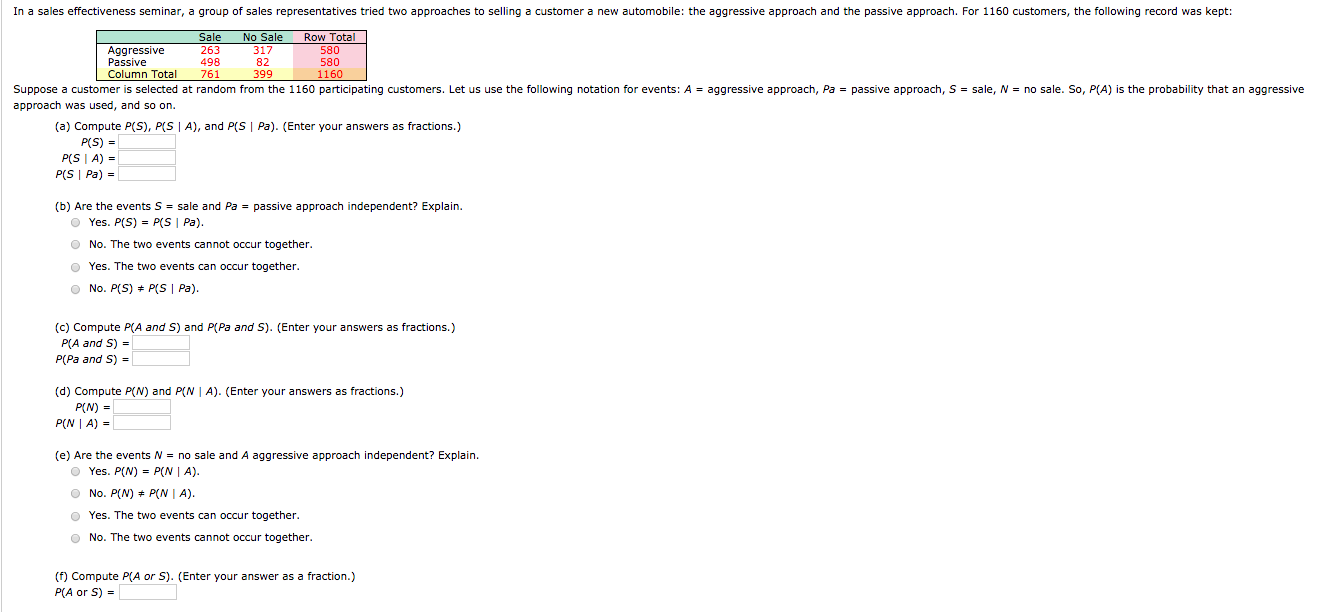In a sales effectiveness seminar, a group of sales representatives tried two approaches to selling a customer a new automobile: the aggressive approach and the passive approach. For 1160 customers, the following record was kept: Aggressive Passive Column Total Sale 263 498 761 No Sale 317 82 Row Total 580 580 399 1160 Suppose a customer is selected at random from the 1160 participating customers. Let us use the following notation for events: A = aggressive approach, Pa = passive approach, S = sale, N = no sale. So, P(A) is the probability that an aggressive approach was used, and so on. (a) Compute P(S), P(S | A), and P(S | Pa). (Enter your answers as fractions.) P(S) = P(S | A) = P(S | Pa) = (b) Are the events S = sale and Pa = passive approach independent? Explain. O Yes. P(S) = P(S | Pa). O No. The two events cannot occur together. O Yes. The two events can occur together. O No. P(S) * P(S | Pa). (c) Compute P(A and S) and P(Pa and S). (Enter your answers as fractions.) P(A and S) = P(Pa and S) = (d) Compute P(N) and P(N | A). (Enter your answers as fractions.) P(N) = P(N | A) = (e) Are the events N = no sale and A aggressive approach independent? Explain. O Yes. P(N) = P(N | A). O No. P(N) + P(N | A). O Yes. The two events can occur together. O No. The two events cannot occur together. (f) Compute P(A or S). (Enter your answer as a fraction.) P(A or S) =
In a sales effectiveness seminar, a group of sales representatives tried two approaches to selling a customer a new automobile: the aggressive approach and the passive approach. For 1160 customers, the following record was kept: Aggressive Passive Column Total Sale 263 498 761 No Sale 317 82 Row Total 580 580 399 1160 Suppose a customer is selected at random from the 1160 participating customers. Let us use the following notation for events: A = aggressive approach, Pa = passive approach, S = sale, N = no sale. So, P(A) is the probability that an aggressive approach was used, and so on. (a) Compute P(S), P(S | A), and P(S | Pa). (Enter your answers as fractions.) P(S) = P(S | A) = P(S | Pa) = (b) Are the events S = sale and Pa = passive approach independent? Explain. O Yes. P(S) = P(S | Pa). O No. The two events cannot occur together. O Yes. The two events can occur together. O No. P(S) * P(S | Pa). (c) Compute P(A and S) and P(Pa and S). (Enter your answers as fractions.) P(A and S) = P(Pa and S) = (d) Compute P(N) and P(N | A). (Enter your answers as fractions.) P(N) = P(N | A) = (e) Are the events N = no sale and A aggressive approach independent? Explain. O Yes. P(N) = P(N | A). O No. P(N) + P(N | A). O Yes. The two events can occur together. O No. The two events cannot occur together. (f) Compute P(A or S). (Enter your answer as a fraction.) P(A or S) =
Glencoe Algebra 1, Student Edition, 9780079039897, 0079039898, 2018
18th Edition
ISBN:9780079039897
Author:Carter
Publisher:Carter
Chapter0: Preparing For Algebra
Section: Chapter Questions
Problem 63POT
Related questions
Question

Transcribed Image Text:In a sales effectiveness seminar, a group of sales representatives tried two approaches to selling a customer a new automobile: the aggressive approach and the passive approach. For 1160 customers, the following record was kept:
Aggressive
Passive
Column Total
Sale
263
498
761
No Sale
317
82
Row Total
580
580
399
1160
Suppose a customer is selected at random from the 1160 participating customers. Let us use the following notation for events: A = aggressive approach, Pa = passive approach, S = sale, N = no sale. So, P(A) is the probability that an aggressive
approach was used, and so on.
(a) Compute P(S), P(S | A), and P(S | Pa). (Enter your answers as fractions.)
P(S) =
P(S | A) =
P(S | Pa) =
(b) Are the events S = sale and Pa = passive approach independent? Explain.
O Yes. P(S) = P(S | Pa).
O No. The two events cannot occur together.
O Yes. The two events can occur together.
O No. P(S) * P(S | Pa).
(c) Compute P(A and S) and P(Pa and S). (Enter your answers as fractions.)
P(A and S) =
P(Pa and S) =
(d) Compute P(N) and P(N | A). (Enter your answers as fractions.)
P(N) =
P(N | A) =
(e) Are the events N = no sale and A aggressive approach independent? Explain.
O Yes. P(N) = P(N | A).
O No. P(N) + P(N | A).
O Yes. The two events can occur together.
O No. The two events cannot occur together.
(f) Compute P(A or S). (Enter your answer as a fraction.)
P(A or S) =
Expert Solution
This question has been solved!
Explore an expertly crafted, step-by-step solution for a thorough understanding of key concepts.
This is a popular solution!
Trending now
This is a popular solution!
Step by step
Solved in 7 steps with 7 images

Recommended textbooks for you

Glencoe Algebra 1, Student Edition, 9780079039897…
Algebra
ISBN:
9780079039897
Author:
Carter
Publisher:
McGraw Hill


Glencoe Algebra 1, Student Edition, 9780079039897…
Algebra
ISBN:
9780079039897
Author:
Carter
Publisher:
McGraw Hill
